新目标英语九年级第二单元教案
- 格式:doc
- 大小:63.00 KB
- 文档页数:7
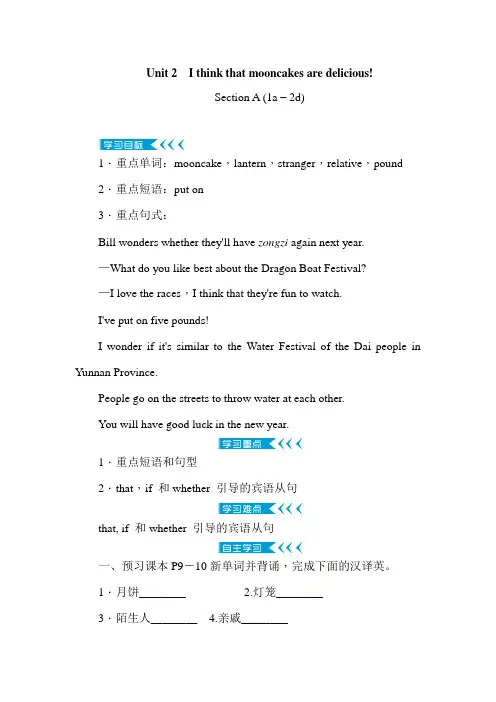
Unit 2I think that mooncakes are delicious!Section A (1a-2d)1.重点单词:mooncake,lantern,stranger,relative,pound2.重点短语:put on3.重点句式:Bill wonders whether they'll have zongzi again next year.—What do you like best about the Dragon Boat Festival?—I love the races,I think that they're fun to watch.I've put on five pounds!I wonder if it's similar to the Water Festival of the Dai people in Yunnan Province.People go on the streets to throw water at each other.You will have good luck in the new year.1.重点短语和句型2.that,if 和whether 引导的宾语从句that, if 和whether 引导的宾语从句一、预习课本P9-10新单词并背诵,完成下面的汉译英。
1.月饼________ 2.灯笼________3.陌生人________ 4.亲戚________5.磅________二、认真预习1a-2d内容找出下列短语和句型。
1.增加________________________________________________________ ________________2.Bill 想知道明年他们是否还能吃粽子。
_______________________________________________________ _________________3.—关于端午节你最喜欢什么?—我喜欢比赛,我认为他们看起来很有趣。
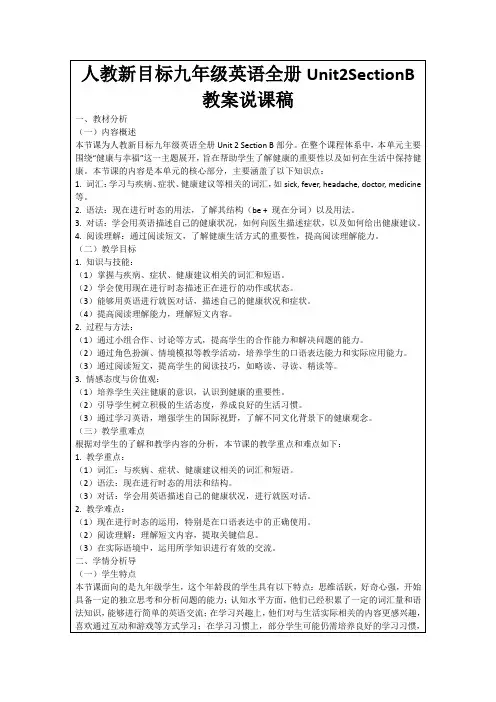
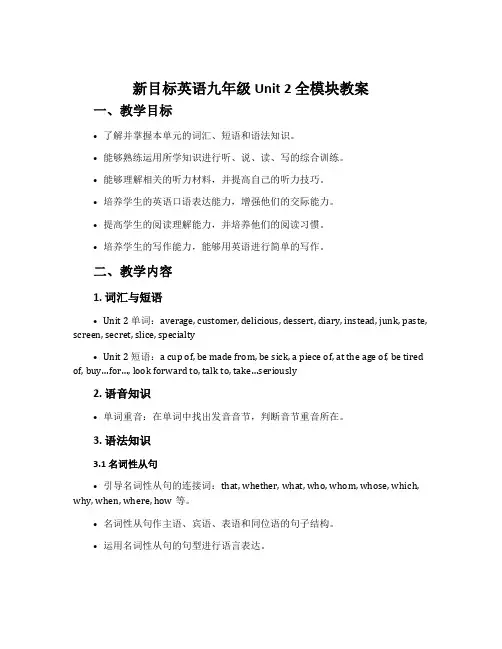
新目标英语九年级 Unit 2 全模块教案一、教学目标•了解并掌握本单元的词汇、短语和语法知识。
•能够熟练运用所学知识进行听、说、读、写的综合训练。
•能够理解相关的听力材料,并提高自己的听力技巧。
•培养学生的英语口语表达能力,增强他们的交际能力。
•提高学生的阅读理解能力,并培养他们的阅读习惯。
•培养学生的写作能力,能够用英语进行简单的写作。
二、教学内容1. 词汇与短语•Unit 2 单词:average, customer, delicious, dessert, diary, instead, junk, paste, screen, secret, slice, specialty•Unit 2 短语:a cup of, be made from, be sick, a piece of, at the age of, be tired of, buy…for…, look forward to, talk to, take…seriously2. 语音知识•单词重音:在单词中找出发音音节,判断音节重音所在。
3. 语法知识3.1 名词性从句•引导名词性从句的连接词:that, whether, what, who, whom, whose, which, why, when, where, how等。
•名词性从句作主语、宾语、表语和同位语的句子结构。
•运用名词性从句的句型进行语言表达。
3.2 定义从句•引导限制性定语从句的连接词:that, which, who, whom, whose•并列使用连接词that的定义从句。
•运用定义从句进行描述和补充说明。
3.3 定语从句•引导非限制性定语从句的连接词:that, which, who, whom, whose•根据先行词在定语从句中的不同成分,选择适当的关系代词和关系副词,并完成句子结构。
•运用定语从句对先行词进行修饰。
3.4 名词性从句与定语从句的比较•名词性从句与定语从句的区别和联系。
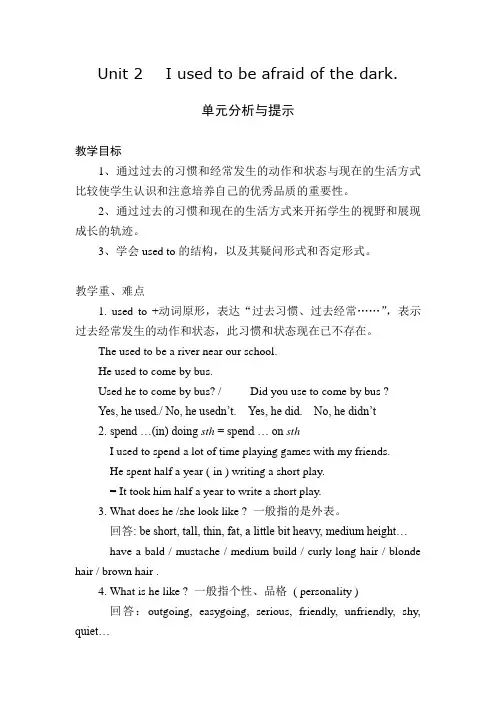
Unit 2 I used to be afraid of the dark.单元分析与提示教学目标1、通过过去的习惯和经常发生的动作和状态与现在的生活方式比较使学生认识和注意培养自己的优秀品质的重要性。
2、通过过去的习惯和现在的生活方式来开拓学生的视野和展现成长的轨迹。
3、学会used to的结构,以及其疑问形式和否定形式。
教学重、难点1. used to +动词原形,表达“过去习惯、过去经常……”,表示过去经常发生的动作和状态,此习惯和状态现在已不存在。
The used to be a river near our school.He used to come by bus.Used he to come by bus? / Did you use to come by bus ?Yes, he used./ No, he usedn’t. Yes, he did. No, he didn’t2. spend …(in) doing sth= spend … on sthI used to spend a lot of time playing games with my friends.He spent half a year ( in ) writing a short play.= It took him half a year to write a short play.3. What does he /she look like ? 一般指的是外表。
回答: be short, tall, thin, fat, a little bit heavy, medium height…have a bald / mustache / medium build / curly long hair / blonde hair / brown hair .4. What is he like ? 一般指个性、品格( personality )回答:outgoing, easygoing, serious, friendly, unfriendly, shy, quiet…目标提示语言目标1. Did Mario used to be short ?Yes, he did. Now he is tall.2. I used to eat candy all the time, didn’t you ?Yes, I did. And I used to chew gum a lot.3. 掌握used to的疑问式及否定式4. 学习下列词汇used to , dark, spider, insect.认知目标学生能运用used to结构,谈论学生自己怎样与过去不同,能准确地描述自己的外貌、性格的变化,灵活运用used to结构处理和传递信息。
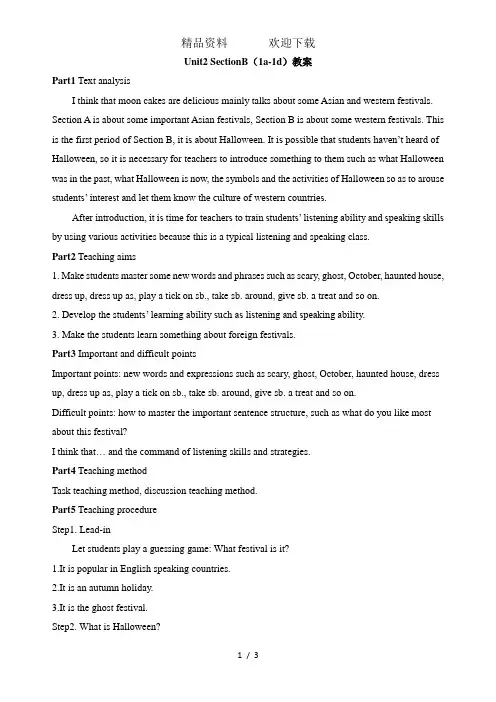
Unit2 SectionB(1a-1d)教案Part1 Text analysisI think that moon cakes are delicious mainly talks about some Asian and western festivals. Section A is about some important Asian festivals, Section B is about some western festivals. This is the first period of S ection B, it is about Halloween. It is possible that students haven’t heard of Halloween, so it is necessary for teachers to introduce something to them such as what Halloween was in the past, what Halloween is now, the symbols and the activities of Halloween so as to arouse students’ interest and let them know the culture of western countries.After introduction, it is time for teachers to train students’ listening ability and speaking skills by using various activities because this is a typical listening and speaking class.Part2 Teaching aims1. Make students master some new words and phrases such as scary, ghost, October, haunted house, dress up, dress up as, play a tick on sb., take sb. around, give sb. a treat and so on.2. Develop the s tudents’ learning ability such as listening and speaking ability.3. Make the students learn something about foreign festivals.Part3 Important and difficult pointsImportant points: new words and expressions such as scary, ghost, October, haunted house, dress up, dress up as, play a tick on sb., take sb. around, give sb. a treat and so on.Difficult points: how to master the important sentence structure, such as what do you like most about this festival?I think that… and the command of listening skills and strategies.Part4 Teaching methodTask teaching method, discussion teaching method.Part5 Teaching procedureStep1. Lead-inLet students play a guessing game: What festival is it?1.It is popular in English speaking countries.2.It is an autumn holiday.3.It is the ghost festival.Step2. What is Halloween?Make students know what Halloween was in the past and what Halloween is now by reading a short passage.Step3. The symbols of HalloweenMake student know the symbols of Halloween by watching a video and showing some pictures. Then play a fast reaction game to check whether students master the knowledge or not. And it is a good chance to make students more active.Step4. The activities of Halloween1.make pumpkin lanterns2. dress up3. trick and treat and so onStep5. BrainstormLet students think of some other fun activities.Step6.Listen practice:(1). Where is Halloween popular?(2). When do people celebrate Halloween?(3). What does Wu Yu think of this festival?(4). Listen again and fill in the blanks.(5). Do you think Halloween will become popular in China?Step7. RetellingLook at the pictures and try to retell the article.Step8. Role play 2d and make conversations in pairs.Step9.DebateWhat do you think of Halloween?/Why? Is it fun or scary?Step10.Let students ask one of their classmates about his favorite festival.Step11. Homework:Write a passage about your favorite festival.Part6Blackboard DesignWhat is Halloween, the symbols of Halloween,the activities of Halloween on the left. The important words and phrases on the right.Part7 Teaching reflectionI think students will be active in class, because they are interested in this topic. I should give students more time to think by themselves and provide them with more chances to practice with their partners, then ask more students to show themselves and encourage them to do it actively.。
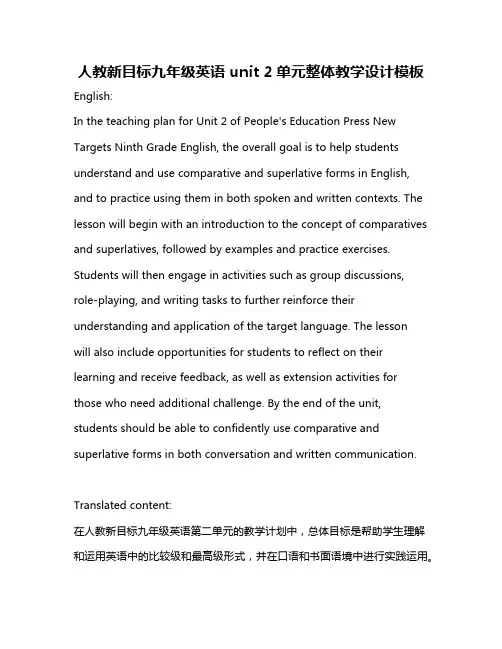
人教新目标九年级英语 unit 2单元整体教学设计模板English:In the teaching plan for Unit 2 of People's Education Press New Targets Ninth Grade English, the overall goal is to help students understand and use comparative and superlative forms in English, and to practice using them in both spoken and written contexts. The lesson will begin with an introduction to the concept of comparatives and superlatives, followed by examples and practice exercises. Students will then engage in activities such as group discussions,role-playing, and writing tasks to further reinforce their understanding and application of the target language. The lessonwill also include opportunities for students to reflect on their learning and receive feedback, as well as extension activities for those who need additional challenge. By the end of the unit, students should be able to confidently use comparative and superlative forms in both conversation and written communication.Translated content:在人教新目标九年级英语第二单元的教学计划中,总体目标是帮助学生理解和运用英语中的比较级和最高级形式,并在口语和书面语境中进行实践运用。
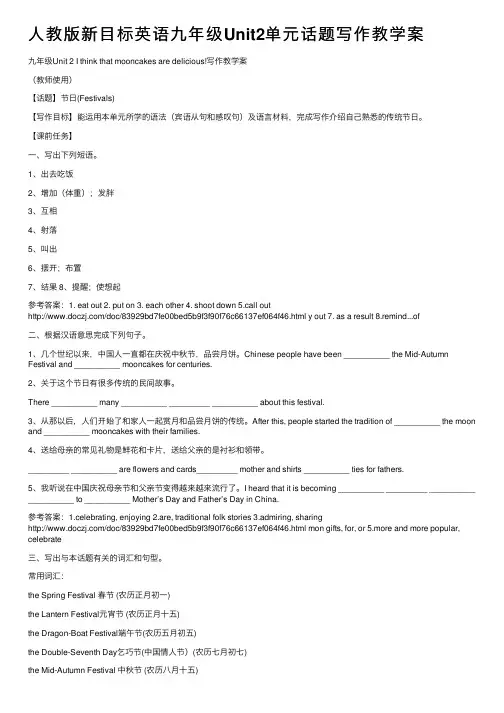
⼈教版新⽬标英语九年级Unit2单元话题写作教学案九年级Unit 2 I think that mooncakes are delicious!写作教学案(教师使⽤)【话题】节⽇(Festivals)【写作⽬标】能运⽤本单元所学的语法(宾语从句和感叹句)及语⾔材料,完成写作介绍⾃⼰熟悉的传统节⽇。
【课前任务】⼀、写出下列短语。
1、出去吃饭2、增加(体重);发胖3、互相4、射落5、叫出6、摆开;布置7、结果 8、提醒;使想起参考答案:1. eat out 2. put on 3. each other 4. shoot down 5.call out/doc/83929bd7fe00bed5b9f3f90f76c66137ef064f46.html y out 7. as a result 8.remind...of⼆、根据汉语意思完成下列句⼦。
1、⼏个世纪以来,中国⼈⼀直都在庆祝中秋节,品尝⽉饼。
Chinese people have been __________ the Mid-Autumn Festival and __________ mooncakes for centuries.2、关于这个节⽇有很多传统的民间故事。
There __________ many __________ _________ __________ about this festival.3、从那以后,⼈们开始了和家⼈⼀起赏⽉和品尝⽉饼的传统。
After this, people started the tradition of __________ the moon and __________ mooncakes with their families.4、送给母亲的常见礼物是鲜花和卡⽚,送给⽗亲的是衬衫和领带。
_________ __________ are flowers and cards_________ mother and shirts __________ ties for fathers.5、我听说在中国庆祝母亲节和⽗亲节变得越来越来流⾏了。
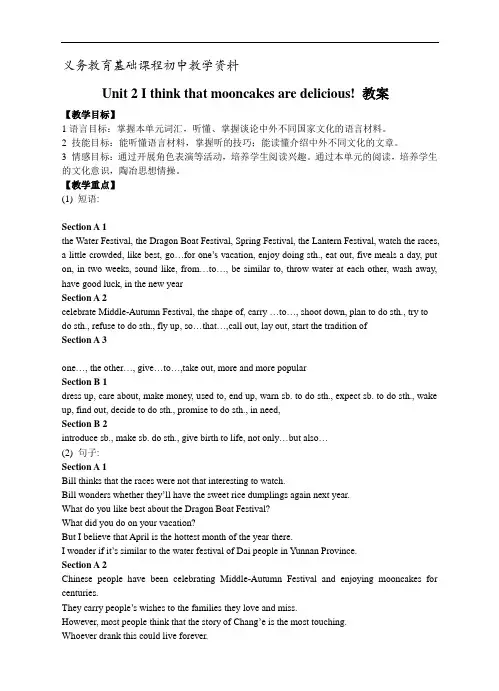
义务教育基础课程初中教学资料Unit 2 I think that mooncakes are delicious! 教案【教学目标】1语言目标:掌握本单元词汇,听懂、掌握谈论中外不同国家文化的语言材料。
2 技能目标:能听懂语言材料,掌握听的技巧;能读懂介绍中外不同文化的文章。
3 情感目标:通过开展角色表演等活动,培养学生阅读兴趣。
通过本单元的阅读,培养学生的文化意识,陶冶思想情操。
【教学重点】(1) 短语:Section A 1the Water Festival, the Dragon Boat Festival, Spring Festival, the Lantern Festival, watch the races, a little crowded, like best, go…for one’s vacation, enjoy doing sth., eat out, five meals a day, put on, in two weeks, sound like, from…to…, be similar to, throw water at each other, wash away, have good luck, in the new yearSection A 2celebrate Middle-Autumn Festival, the shape of, carry …to…, shoot down, plan to do sth., try to do sth., refuse to do sth., fly up, so…that…,call out, lay out, start the tradition ofSection A 3one…, the other…, give…to…,take out, more and more popularSection B 1dress up, care about, make money, used to, end up, warn sb. to do sth., expect sb. to do sth., wake up, find out, decide to do sth., promise to do sth., in need,Section B 2introduce sb., make sb. do sth., give birth to life, not only…but also…(2) 句子:Section A 1Bill thinks that the races were not that interesting to watch.Bill wonders whether they’ll have the sweet rice dumplings again next year.What do you like best about the Dragon Boat Festival?What did you do on your vacation?But I believe that April is the hottest month of the year there.I wonder if it’s similar to the water festival of Dai people in Yunnan Province.Section A 2Chinese people have been celebrating Middle-Autumn Festival and enjoying mooncakes for centuries.They carry people’s wishes to the families they love and miss.However, most people think that the story of Chang’e is the most touching.Whoever drank this could live forever.Hou Yi was so sad that he called out her name to the moon every night.How he wished that Chang’e could come back!Section A 3Do you know that there are two special days for parents in America?I believe that there are many ways to show our love.It is also a good idea to help parents to do something instead.Section B 1Many would agree that when we think of Christmas, we probably think of gifts, Christmas trees and Santa Claus.A Christmas Carol is a famous novel written by Charles Dickens.He just cares about whether he can make more money.Marley used to be just like Scrooge, so he was punished after he died.He now treats everyone with kindness and warmth, spreading love and joy everywhere he goes.Section B 2Not only do people spread them around in different hiding places for an egg hunt, but they also give out these treats as gifts.【教学难点】1. 学会运用宾语从句来表达句子。

(此文档为word格式,下载后可以任意修改,直接打印使用!)Unit2 SectionA(3a—3c)优质课教案1教学目标1. To learn some key words and useful expressions.2. To know about the story about Chang’e.3. To improve the skills of reading and telling stories4. To learn about the Chinese cultures.2学情分析Teenagers like stories. And the topic is about one of Chinese traditional festivals which are related to our real life, so they must be interested in reading this passage.3重点难点1. Key points:a. Learn the new words and target language by themselves.b. Learn to finish a mind-map.2. Difficult points:a. Learn to retell the story according to the mind-map.b. Improve students’ reading and comprehensive skills.4教学过程4.1 一学时4.1.1 教学活动活动1【导入】Leading-in. (Pre-reading)Play the song “Prelude to Water Melody”, showing several pictures of the full moon on the screen. Then ask students what they can think of when they listen to the song.(Brainstorm.) (Aim: To arouse the students’ interests.)T: I can think of the full moon. Well, when we enjoy the full moon, we can have full feelings. Show the title “Full Moon, Full Feelings” on the screen.1. Ask students what festival can they think of when they see the title.(The students may answer the Mid-Autumn Festival.)2. Introduce the festival’s time, food and activities.活动2【讲授】Presentation(While-reading)1 Fast reading: Read the passage quickly and find the main idea.A. How people celebrate the Mid-Autumn FestivalB. Why Cheng'e flew up to the moonC. A traditional folk story about the Mid-Autumn Festival(It aims to get Ss to know the reading strategy-skimming and get the main idea.)2 Careful reading:1. Read Para.1 and answer two questions.(What do mooncakes look like? Why do people celebrate the Mid-Autumn Festival?)Read Para.2 and finish the four tasks.Underline the four characters and circle what they did in the story.2. Match the characters with what they did.3. Finish the mind-map according to the pictures.4. Complete 3b. (put them in the correct order)Read Para.3 and fill in the blanks.People often celebrate the Mid-Autumn Festival by a_______ the moon, s_______ the mooncakes with families and l_______ to the folk stories.活动3【活动】Practice (Post-reading)1. Get Ss to listen to the story carefully and then do 3c.2. Get them to have a memory challenge by retelling the story with the help of the mind-map. (Group work) (It aims to improve Ss’ listening and speaking skills.)3. Get Ss to evaluate the four characters using the objective clause.I think that Hou Yi is brave/loyal.I think that the Goddness is______.I think that Pang Meng is______.I think that Chang’e is______. (It aims to emphasize something important in our life.)4. Group work: Continue to make u p Chang’e stor y.Have Ss work in groups and discuss how their group will make the story “full”. Get them to write in a group.Invite some groups to present their stories.(It aims to improve students’ writing and speaking skills. Besides, get students to be cooperative.)活动4【作业】Homework: Contin ue to write the story of Chang’e.。
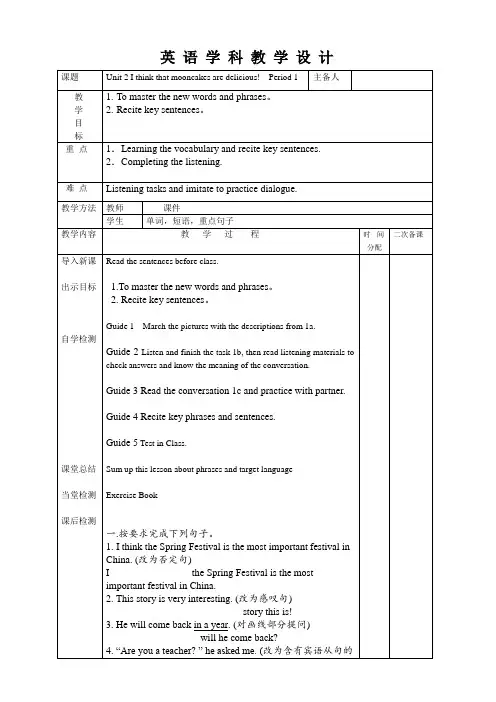
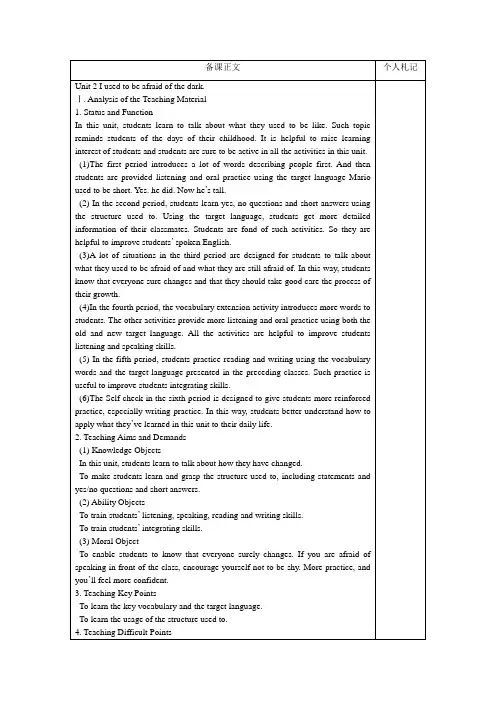
Unit 2 I think that mooncakes are delicious?第一课时Section A 1 (1a-2d)一、教学目标:1. 语言知识目标:1) 能掌握以下单词及短语:stranger, relative, pound, sound like, put on, be similar to能掌握以下句型:① What do you like best about the Dragon Boat Festival?② I’ve put on five pounds.③I wonder if it’s similar to the Water Festival of the Dai people in Yunnan Province.④ People go on the streets to throw water at each other.⑤ Because the new year is a time for cleaning and washing away bad thing.2) 识别以what和how引导的感叹句;说出宾语从句的概念、用法及注意的问题;运用宾语从句描述节日的由来及每个节日代表的象征意义。
3)初步掌握运用宾语从句描述庆祝节日的活动情况。
2. 情感态度价值观目标:通过开展角色表演等活动,培养学生阅读兴趣。
通过本单元的阅读,获得文化知识,理解文化内涵,比较文化异同,吸收文化精华,形成正确的价值观和自信、自尊、自强的品格,建构一定的跨文化沟通和传播中华优秀文化的能力。
二、教学重难点1. 教学重点:1) 初步认识that,if 和whether 引导的宾语从句。
2) 初步运用宾语从句对自己喜欢的节日进行简单的描述,并能熟练运用本课时的单词和词组进行有关节日的对话交流。
2. 教学难点:初步运用宾语从句对自己喜欢的节日进行简单的描述,并能熟练运用本课时的单词和词组进行有关节日的对话交流。
Unit 2 I used to be afraid of the darkThe Fifth PeriodⅠ. Teaching Aims and Demands1. Knowledge Objects(1)Key Vocabularyright, comic(2) Practice reading and writing using the target language.2. Ability Objects(1)Train students’ ability to get in formation in reading or in conversation.(2)Train students’ ability to express their ideas using the target language.3. Moral ObjectTalk to your parents as often as possible so that you can understand each other better.Ⅱ. Teaching Key PointPractice reading and writing using the target language.Ⅲ. Teaching Difficult PointWrite a passage about how someone’s life has changed.Ⅳ. Teaching MethodPractice methodⅤ. Teaching Aids1. A projector2. A sample versionⅥ. Teaching ProceduresStep I RevisionReview the target language presented in this unit. Invite a student to come to the front of the classroom and demonstrate an activity. The rest of the class guess what he/she is doing first. Then make sentences using the words "used to" and the guessed activity. Demonstrate how to play the game.A student pretends that he/she is drinking milk.T: What is he/she doing?S s: He/She is drinking milk.T: You are right. OK. Please make sentences using "used to" and "drink milk".S1:I used to drink milk a lot. Now I don’t like to drink milk at all.S2:I didn’t use to drink milk. But now I like milk very much.S3:…Step Ⅱ 3aThis activity provides reading practice using the target language.Teach the words right and comic.Call students’ attention to the article. Invi te a student to read it to the class. Correct any pronunciation errors to make sure the student provides a good model for the rest of the class.Point out the chart. Elicit the first answer from the class: Rose Tang then. had so much time. Guide students to find out the information in the reading. It says when I was young, I used to have so much time,…Say, Now read the article and complete the chart.Get students to do the work on their own. As they work, move around the classroom and offer help if necessary.Correct the answers.AnswersRose Tang then: had so much time; spent a lot of time playing games with my friends; watching TV or chat with my grandmother; went to concerts with my fatherRose Tang now, gets up early and stays in school all day; has no time for playing games; has to study; has no time for concerts; does homework and goes to bed Step Ⅲ 3bThis activity provides reading and writing practice using the target language. Read the instructions to the class.Read the letter to the class. Do the first one or two fill-ins with the class. Say, Please complete the letter on your own. You may use the information from the chart in Activity 2b.Ask students to work individually. Walk around the room checking progress answering questions as needed.Ask different students to read their completed letters to the class.Note: Answers will vary.Step Ⅳ 3cThis activity provides writing practice using the target language.Read the instructions to the class.Demonstrate how to do the activity. Ask students to take turns suggesting things that they used to do and that they still do. Make two columns with the headlines Used to and Now on the blackboard.Say, Write an article about the things that you used to do and that you still do to describe how your life has changed since primary school. Use these suggestions on the blackboard with your ideas to write your article. You may also use the articles in Activities 3a and 3b as a model.Show the following sample version on the screen by a projector as a guide.Ask students to do the activity individually. As they begin to write, move around the room providing help as needed. It doesn’t matter whether they only write a sentence or a longer article.Ask students to read their articles to a partner.If there isn’t enough time for all the students to finish the article, allow them to finish it after class.The answer will vary.S tep Ⅴ 4aThis activity provides reading, writing, listening and speaking practice using the target language.Read the instructions to the class.Focus attention on the chart. Set a time limit of one minute. Students read the headlines at the top and at the sides.Demonstrate how to fill in the chart with a good students to provide a good model for the rest of the class.T: What kind of books do you like reading, Wei Ming?W: I like reading comics.T: How about music?W: I like listening to pop music.T: …Make a simple chart on the blackboard and ask Wei Ming to fill in his information in the chart.Ask students to complete the work on their own. They may remember or guess what their parents used to do. Assign part of their task to homework so that students may talk to their parents. Answers will vary.Step Ⅵ 4bThis activity provides oral practice using the target language.Read the instructions to the class.Ask students to complete the work in groups.Ask a few students to tell the class about the other students they have talked to. Step Ⅶ SummarySay, In this class, we’ve done much practice in reading and writing as well as speaking the target language.Step Ⅷ Homework(1) Talking to their parents, students fill in the information in the chart in Activity 4a.(2)Finish off the activity in Activity 4b.Write a passage about students and their parents.Step Ⅸ Blackboard Design。
新⽬标九年级英语(新)Unit2全单元教案九年级英语教案课题:Unit 2 I think that mooncakes are delicious!课时:5教学⽬标A类:1.Vocabulary:the Water Festival, the Dragon Boat Festival, Spring Festival, the Lantern Festival, watch the races, a little crowded, like best, go…for one’svacation, enjoy doing sth., eat out, five meals a day, put on, in two weeks, sound like, from…to…, be similar to, throw water at each other, wash away, have good luck, in the new year2. Bill thinks that the races were not that interesting to watch.Bill wonders whether they’ll have the sweet rice dumplings again next year. What do you like best about the Dragon Boat Festival?B类:复习所学的重难点句型及句式结构。
⽤所学的功能语⾔讨论你所喜欢的节⽇。
C类:了解西⽅的⼀些传统节⽇,掌握和运⽤宾语从句等知识点。
了解中华传统⽂化,弘扬中华民族精神,激发学⽣爱我中华的热情。
个体学习⽅案①What a great day!② I think that they are fun to watch.③ How he wished that Chang'e could come back!Teaching Contents 学⽣课堂练习有效⽣成The First periodSection A (1a-2d) ⼀、教学⽬标:语⾔知识⽬标:1) 能掌握以下单词:mooncake, lantern, stranger, relative, put on, pound , in two weeks能掌握以下句型:Read the words after①What a great day! 多好的⼀天啊!②Wow,sounds like fun!哇,听起来真有趣啊!③I think that they are fun to watch.我认为它们看起来很有趣。
新目标九年级英语Unit 2 I used to be afraid of the dark.教学设计主备: 陈奉莲审查:陈奉莲使用:栏杆镇英语教师Unit 2 I used to be afraid of the dark.教学设计主备:陈奉莲审查:陈奉莲使用:栏杆镇英语教师单元分析1.本单元主要内容是学会used to结构。
Used to +动词原形表示过去经常、以前常常,只用于过去式中,用来表示现在已不存在的习惯或状态。
例如:They used to play football together.他们过去常在一起蹋足球。
(现在不在一起踢了)2.used to的疑问形式和否定形式为Did you use to…?和I didn’t use to…也可以用Used you to…?和I used not to…但现在多使用前者。
例如:Did you used to swim in the river? 你过去常在河里游泳吗?I didn’t use to play the piano.我以前并不经常弹钢琴。
教学目标一、学习目标(Language Goal)1.学会陈述自己过去常做的事情。
2.学会陈述自己过去的爱好等。
3.能够表达自己现在和过去在外表、性格、娱乐等方面的变化。
4.能够表达朋友、家人等现在和过去的变化。
二、语言结构(Language Structures)1.I used to be short when I was young. 我年轻时个子很矮。
2.—Did you use to have straight hair? 你过去是直发吗?—Yes, I did. 是的。
3.—Did you use to play the piano? 你过去弹钢琴吗?—No, I didn’t. 不,我不弹。
4.I used to be afraid of dark. 我过去害怕黑暗。
5.I’m terrified of the snakes. 我害怕蛇。
Unit 6 I like music that I can dance to.Language goals:1. Learn how to express preferences and causes.2. Write a review of a book, a movie or a CD.New languages:1. Rosa likes music that’s quiet and gentle.2. --- What kind of music do you like?---I like music that I can sing along with.3. --- What kind of singers do you love?--- I love singers who write their own music.4. ---Why do you like this CD?---This music is great because you can dance to it.Difficult points:Relative clauses with that and whoTeaching aids:computer, video, recorderTeaching periods:Period 1: Section A 1a /1b /1c 2a /2b /2c/ Grammar Focus /4Period 2: Section A 3a /3b SectionB.1/2a/2b/2cPeriod 3: Section B 3a /3b /3c/4 /Self check1, 2Period 4: ReadingPeriod 1Teaching procedure:Step 1. Lead-in and warming upPlay different kinds of music. Let students listen and tell the names of singersand songs. a. Play the first song for students, ask like this:T: Do you like this piece of music?Is it too loud or gentle? Write the students` answer on the Bb, then elicitstudents to get the summary like this: I like the music that is too loud. …b. Play the second song for students. Ask, “Who’s the singer`? Do you lovethis singer? Why?” Collect the students` answers on the Bb to get thesummary like this: I love the singer who is handsome / beautiful …c. Game: The Word BankWrite some useful words and phrases about this topic on the Bb, encouragestudents to use the words in the “bank” to talk about their favorite and why bymaking similar sentences.Invite students to say their sentences, if necessary, let them know we use the word who to describe the people.Step 2. Section A 1b 1c listening and presentationSay, you will hear Tony and Betty talking about the kinds of music each one likes.Play the recording the first time, students only listen. Then answer the questions and finish 1b.Play it a second time .this time ask students to repeat after each stop and check the answers in1b.Role-play this conversation.Step 3. Section A 2a, 2b, 2c listening and writingAsk students to read the statements in 2a and explain some key points.Say, now you will hear Carmen and XuFei are discussing the pictures on T-shirts. They have different ideas. What kind of group do they like? What kind of music do they hate? Listen carefully, finish 2a and 2b.Play the tape for the first time, finish 2a.Play it again, make some stops to let students repeat, and complete the sentences in the chart of 2b.Pair work: Make conversations using the information from 2a and 2b. Invite some of them to show their dialogues.Step 4. Section A 4. Pair work CompetitionT: Ask students work in pairs to talk more about this topic and give their reasons, and they need to show their opinions by finishing the following sentences: I like music that …I love singers who …I can’t stand music that …I don’t like musicians who…Invite some pairs to share their ideas about this topic, and read their sentences to the others, and encourage the others to check the mistakes.Step 5. Section A Grammar Focus and SummaryRead the key sentences in Grammar Focus. Then ask several students to write down their own sentences in Part 4 on the Bb, elicit them to find out how to use “ who” and “that” in the Attributive Clause; also point to the sentences on Bb, let them know when they use “ the singer” instead of” singers” , they should use “writes” instead of “write”.Elicit students to make a summary about what they learn this class.Step 6. Homework1. Write a dialogue to show your own preference by using the sentencepatterns.2. Recite 1b, and remember the useful phrases.Period 2Teaching procedure:Step 1. Warming upAsk some students to talk about the target language that they have learned last class.Step 2. Section A3b, 3a Listening and presentationA.3b Pairwork Ask students to talk about a CD they listened to recently by discussing the following questions,What’s the name of your favorite CD?Why do you like it?What do you dislike about this CD?What does it remind you of?B. Books closed. Listen to Jennifer’s CD review. Try to write down some information about the answers to the questions.C. Books open. Read 3a by themselves and check the answers, then match the sentence parts and tell why.d. invite some students to explain some key words and sentences, elicit students to say them another way.Step 3. Section B Practice 1, 2a, 2b, 2ca.Discussion: Give them some other topics, such as band, fruit, books, movies andso on, to let them show their preferences orally by using the sentence structures.And finish Part 1.b.Say, you will hear two boys talking about some of the things they see in the room.Write the three things they talk about.c.Play the tape for the first time, just listen and finish 2a; listen again, read after thetape and finish 2b.d.Check the answers.Step 4. SummaryAsk students to talk about what they learn this class. Encourage students to say more about the usage of the Attributive Clause.Step 5. Homework1.Recite 3a and the other key phrases and sentences.2. Use 3a and 2b as the model; make your own dialogues by talking about one ofthese topics.Period 3Teaching procedure:Step 1. Lead-in and reading (Section B 3a, 3b)a. Ask some students to read their dialogues to the class, and let the others take some notes about the name of it, the reason they like it and the reason they dislike it.b. Write the term pro and con on Bb, and explain it to the students, then invite the other students to tell the pros and cons of each dialogue.c. Books open. Let students read the reviews of 3a by themselves, and try to complete 3b.d. Ask the questions about the pros and cons of 3b to check the answers.e. Read after the tape, then discuss the words and sentences they don’t understand of 3a in groups.f. Invite one of each group to explain these items in their own words, if necessary, the teacher can give some explanation, esp. the difficulties.g. Let students find out some useful phrases and sentence patterns of the three reviews, and use them to make their own sentences.Step 2.Groupwork 4Ask students to fill in the calendar with special events. Ask them to discuss “what would you prefer to do?”Step 3. Practice Self check 1a.Before students do the exercise 1, let them pay attention to the way to fill in theblank.b.Ask the students to tell the different forms of one word, and then choose the correctform.c.Invite some to make their sentences, let the rest students tell they’re right or wrong,and make them correct.Step 4.Reading and writing Self check 2Read the instructions to the class. Explain that the reply should include as much detail as what the student replying plans to do.Read by themselves and discuss a list of things that they need to reply to Ling Ling. Step 5. Homework1. Change your own dialogue about your preference into a review by making 3a asa model.2. Write your own replies in Self check 2 according to the discussion.Period 4Teaching procedure:Step 1. Before you read oral practice Section4a.Ask students some questions:Are you a vegetarian?Do you care how much fried food you eat?Do you prefer to drink water when you are thirsty?Do you only eat food you like?b.Give some comments about their answers and let students discuss whichdiet is healthier and why.Step 2.While readinga. Let students pay attention to the learning strategy, let them know some ofstyles of English.b.Listen to the passage for the first time, try to tell what style this passage is.Then finish3b.c.Read for the first time, check the answer of 3b, and fill in the chart below.Step 3. After you read 3a 3cRead aloud the dialogue by themselves, then finish 3a.Write down the answers of 3c according to your memory, and then check your answers by reading again.Step 4. Summary and Writing:1. Encourage students to review what they have learned about the reading , andmake a list of useful phrases and sentences.2. Write down their articles about this topic. After finishing them, ask somestudents to read out their own passages and others assess them together.Step 5. Homework1.Finish exercises of this unit.2. Review the whole unit and preview Unit 7.。